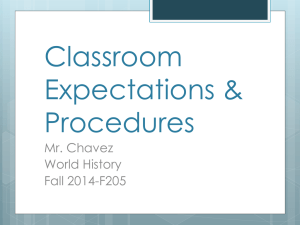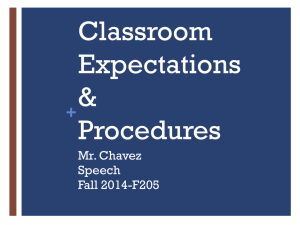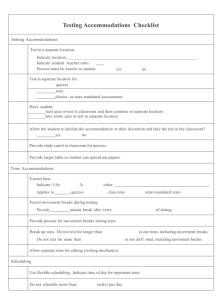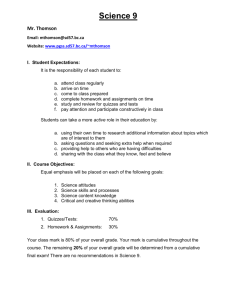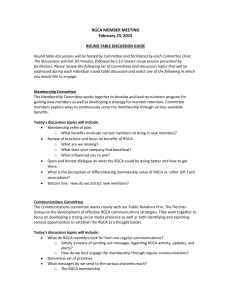syllabus.2014 - Southern Adventist University
advertisement
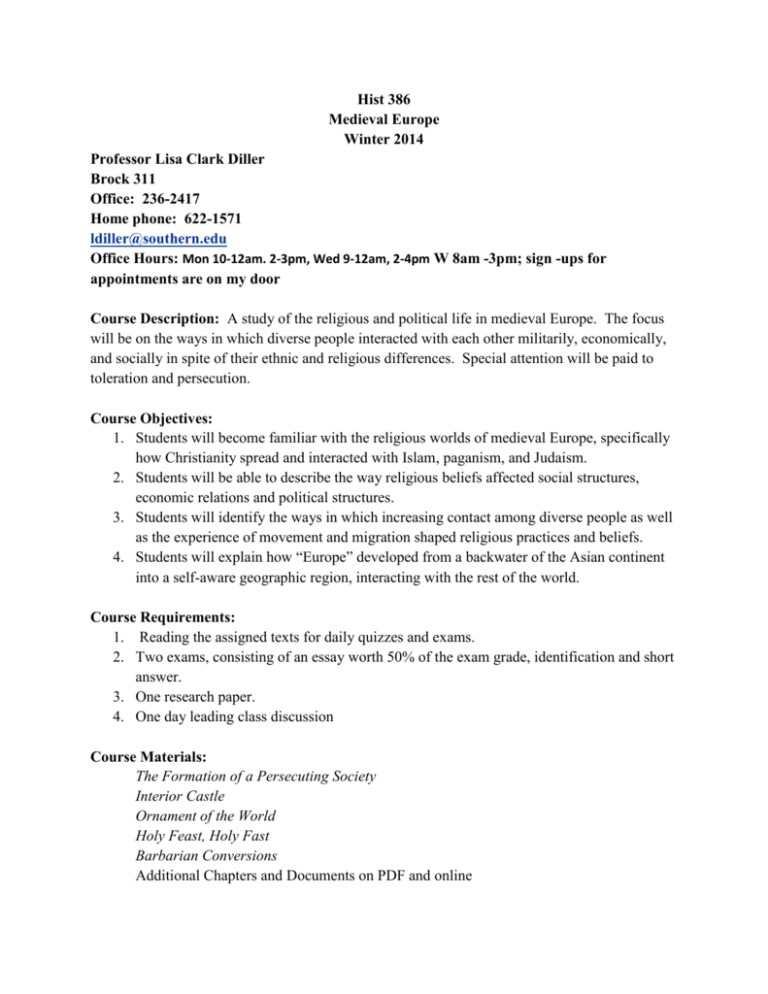
Hist 386 Medieval Europe Winter 2014 Professor Lisa Clark Diller Brock 311 Office: 236-2417 Home phone: 622-1571 ldiller@southern.edu Office Hours: Mon 10-12am. 2-3pm, Wed 9-12am, 2-4pm W 8am -3pm; sign -ups for appointments are on my door Course Description: A study of the religious and political life in medieval Europe. The focus will be on the ways in which diverse people interacted with each other militarily, economically, and socially in spite of their ethnic and religious differences. Special attention will be paid to toleration and persecution. Course Objectives: 1. Students will become familiar with the religious worlds of medieval Europe, specifically how Christianity spread and interacted with Islam, paganism, and Judaism. 2. Students will be able to describe the way religious beliefs affected social structures, economic relations and political structures. 3. Students will identify the ways in which increasing contact among diverse people as well as the experience of movement and migration shaped religious practices and beliefs. 4. Students will explain how “Europe” developed from a backwater of the Asian continent into a self-aware geographic region, interacting with the rest of the world. Course Requirements: 1. Reading the assigned texts for daily quizzes and exams. 2. Two exams, consisting of an essay worth 50% of the exam grade, identification and short answer. 3. One research paper. 4. One day leading class discussion Course Materials: The Formation of a Persecuting Society Interior Castle Ornament of the World Holy Feast, Holy Fast Barbarian Conversions Additional Chapters and Documents on PDF and online Include Rule of St. Benedict, Einhard on Charlemagne, Procopius, the Burgundian code, Class policies: Attendance is kept through collection of quizzes or other daily work due at the beginning of class. If you are tardy, please verify with me after class that I have you down as “present” even if you were unable to take the quiz. Laptops may be used to take notes in class. Those who use laptops must sit in the front row. If for any reason it appears that a student is not using laptops for taking notes, I will ask that student to no longer use a laptop in class. All other digital devices are prohibited without express permission of the teacher. Students must keep cell phones and PDAs in their book bags, with cell phones turned off. Quizzes are given at the beginning of the class. No make-up quizzes are allowed and no extra time is given for those who are late. Any dishonesty (i.e., taking credit for work you did not do, copying from anyone in class or outside of class) will result in failure of the assignment and may result in failure of the entire course. Assignments are due on the dates indicated. Ten percent is deducted for each day an assignment is late. Grades are given on a strict point basis. All points count for the same weight and your grade is the amount of points you got out of the total amount of points possible. I do NOT accept emailed homework assignments. You will not receive credit unless you give me a hard copy of your work. You may, however, use recycled paper. Absence Policy *If you are absent, no matter what the reason, you are responsible for obtaining the information covered during that class, including any handouts. *Your four lowest quiz scores will be dropped, and if you are absent more than four times, you will have five points deducted for each absence. Leaving early counts as an absence. *There is no distinction between excused and unexcused absences—I give you four free absences, use them wisely. *If you are absent only one time, you will receive 2% on top of your grade at the end of the semester. *If you are absent 8 times or more, you will automatically fail the class. Description of Research Paper and Process: Research paper will be 8-10 pages 1 1/2-space, Chicago Manual of Style. Students will choose a question to answer and use at least 2 primary sources and 6 secondary sources to answer the question. Students will use a map to make and illustrate their point and to set their subject into the geographic conquest of Europe. The student will receive points for each of the following in the process: 1. Question/bibliography/outline—10 points 2. Rough draft—40 points (due the night before the conference, in the week after sign-ups) 3. Final draft—60 points See the rubric at the end of the syllabus for exact grading policies Leading Class Discussion Assignment Each student will take a turn leading discussion with another student over the primary document reading for one day’s class. You will both read the assignment carefully ahead of time, prepare a quiz of 5 points with an answer key to accompany it, and decide the discussion questions. You will meet together with Prof. Diller ahead at least 24 hours before the class in order to show her your quiz and your discussion questions. You should have ideas for possible answers/responses to the discussion questions—with page number references to the part of the primary document which students might be referring to in their answers to the questions. Your grade is largely dependent on your preparation for meeting with the professor, and less dependent on the exactly how you handle the class discussion. However, if you either talk too much during the discussion, or don’t steer/direct the conversation in some way, you will receive fewer points. It should also be clear that both people are leading the discussion and not just one dominating…. Grading Scale: A 93-100% A- 90-92% B+ 88-89 % B 83-87% B- 80-82% C+ 78-79% C 73-77% C- 70-72% D+ 68-69% D 63-67% D- 60-62% F 59% and below Disability Statement In keeping with University policy, any student with a disability who needs academic accommodations must call Disability Support Services at 236-2574 or stop by Lynn Wood Hall, room 308, to arrange a confidential appointment with the Disability Services Coordinator during the first week of classes. (Students who request accommodations after the third week of the semester should not depend on receiving accommodations for that semester. Legally, no retroactive accommodations can be provided. For more details, visit the Learning Success Services Web site at http://lss.southern.edu/.) Students whose accommodations requests are approved will be provided confidential letters for them to deliver to their professors for review and discussion about how to implement the accommodations in relation to particular course requirements. Accommodations for disabilities are available only as recommended. Class Schedule Jan 5 Introduction 7 Hollister chapters 3 and 4 12 Fletcher, chapter 2 sign up for research subject 14 Rule of St. Benedict sign up for leading discussion 19 Fletcher, pp. 130-146, 155-159, 160-171, 181-192 21 Fletcher, chapter 7 sign up for conferences over bibliography/outline 26 Fletcher, pp. 228-240, 253-260, 271-278, 284 28 Fletcher, pp. 332-351, 364-368 Feb 2 Fletcher, pp. 369-375, 382-897, 433-437, 442-450 4 Medieval Trade, chapter one Sign up for conferences over first draft 9 Lacey, May, June, July 11 Menocal, pp. 3-50 16 Menocal, pp. 51-90 18 Menocal, pp. 189-215, 244-252 final draft due 23 Medieval Trade, chapter two 25 Midterm Exam Mar 9 Hollister, chapter 10 http://www.fordham.edu/halsall/source/cde-nicea.html; http://web.archive.org/web/20010410021343/http://www.humanities.ccny.cuny.edu/history/read er/13thcpiety.htm; http://www.fordham.edu/halsall/source/usamah2.html 11 Moore, pp. 1-34 16 Moore, pp. 34-65 18 Moore, chapter two 23 Moore, chapter three 25 Moore, chapter four 30 Walker Bynum, chapters 1 and 4 Apr 1 Walker Bynum, chapter 5 6 Walker Bynum, chapters 7 and 8 8 Interior Castle, pp. 23-43, 56-69, 85-94 13 Interior Castle, pp. 126-134, 163-184, 225-235 15 Cantor, chapters three and six 20 Fletcher, chapter 1; Bossy, chapter 1 22 Bossy, chapters 7 and 8 Final Exam, 10:00 a.m., Wednesday, April 28, 2010 Rubric for leading class discussion ___ 18-20. Student came to pre-class meeting with professor preared for planning. Student followed through with emailed draft of class discussion outline. A quiz was planned and graded. Student shared discussion responsibilities with fellow coordinator. Class discussion was facilitated by calling on a variety of people, asking open-ended questions, encouraging others to talk with follow-up questions rather than simply lecturing or dominating the conversation. Questions flowed naturally. All duties were fulfilled promptly. Student cooperated well with cofacilitator. ___ 16-17. Student met with professor, but was not fully prepared with questions or ideas. Class discussion was awkward, with questions not eliciting responses from others. Student leader had some difficulty in working with co-facilitator. There was some delay in returning quizzes. ___ 14-15. Student was not prepared for meeting with professor, and had not seemed to read with understanding. Student either dominated class discussion by lecturing or interrupted conversation rather than allowing space for others to talk. Questions were poorly thought out. Student was too quiet and did not share the load of running the conversation with the other leader. Student was tardy in duties. Rubric for rough draft of research paper Argument _____ (9-10) The author has a clear question she is answering and that answer is clear and strong. It is clear why this is an interesting or important question. The author comes to conclusions regarding the answers to her question throughout the paper. _____ (7-8) The student seems to know what she is writing about, but there isn’t a clear question introduced. The paper may not completely hang together in terms of an argument _____ (5-6) There doesn’t seem to be a question or an argument, just a lot of information that doesn’t add up to any conclusions. The stated question seems irrelevant to the actual evidence offered. Evidence ____ (9-10) The author has used a variety of sources to make her argument. The evidence is clearly lined up with the argument/question. At least two primary documents are used to help with the argument and six secondary sources. ____ (7-8) There is too much dependence on one or two sources. There is too much quoting from the secondary sources. The evidence may be weak for the argument, or a bit unrelated. ____ (5-6) There may not be a primary document used in the paper. The author seems to be summarizing a couple of historians and not using a wide variety of sources. The evidence doesn’t connect to the argument in a clear manner. Style _____ (9-10) The writing is very easy to read. Topic sentences and the primary point are clear. There are clear transitions between paragraphs. The flow of the paper makes it easy for the reader to move from one point to another. Sentences are constructed well and convey the author’s ideas clearly. _____ (7-8) While the author’s point is understandable, it requires some close reading. Transitions are poor. Paragraphs are not organized well and topic sentences are hard to find. Run-on or fragmented sentences make it challenging to find meaning in the paper. _____ (5-6) The paper is choppy, the author’s ideas are all over the place. There are many mistakes in sentence and paragraph structure and no flow to the paper. Details _____ (9-10) There are very few spelling, grammar or punctuation mistakes. Proper citation is used for references and footnotes. Words are used correctly. There is a map included in the paper somewhere. A bibliography is attached. _____ (7-8) There are many spelling, grammar, and punctuation mistakes and some citation mistakes. A map may be missing. _____ (5-6) Spelling, grammar and punctuation mistakes make it hard to read the paper. Citation is ignored or completely wrong. Many words are used incorrectly. Rubric for final draft of paper: Style: 25 points (5 points possible for each) _____Spelling, punctuation, grammar _____Organization and paragraphing, good editing changes based on previous draft _____Citation—correct use of CMS _____Use of thesis statements and topic sentences _____“Felicity of prose” Substance: 35 points (5 points each) _____Clear question _____Clear historical evidence to answer the question _____Use of a variety of sources to answer the question _____Critical thinking—analyzing evidence creatively and thoroughly; showing discernment _____Original thoughts—doesn’t rely too much on quotes or simply summarizing scholars _____Creative Use of a Map _____thoroughness; moving beyond themes from our class discussion to new information
